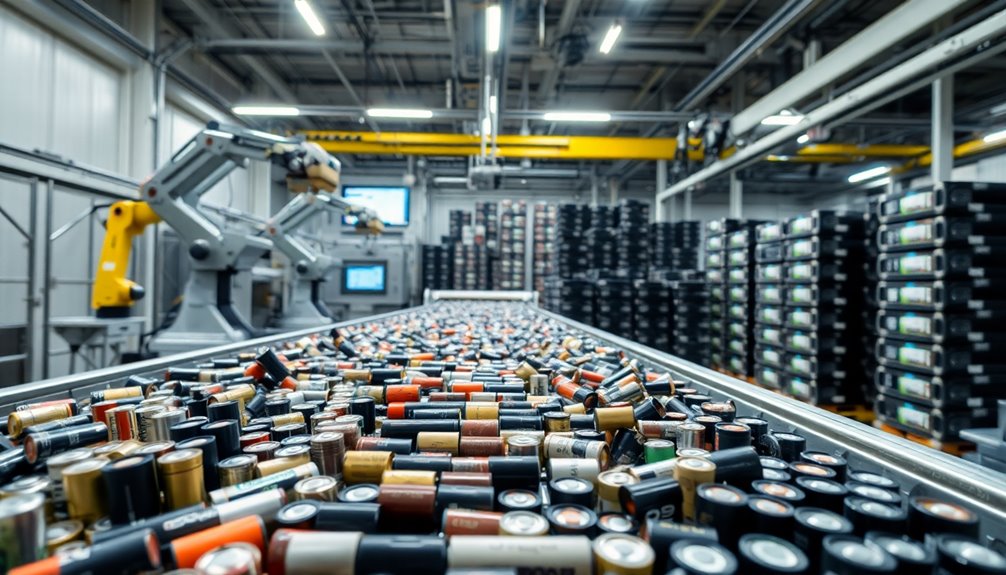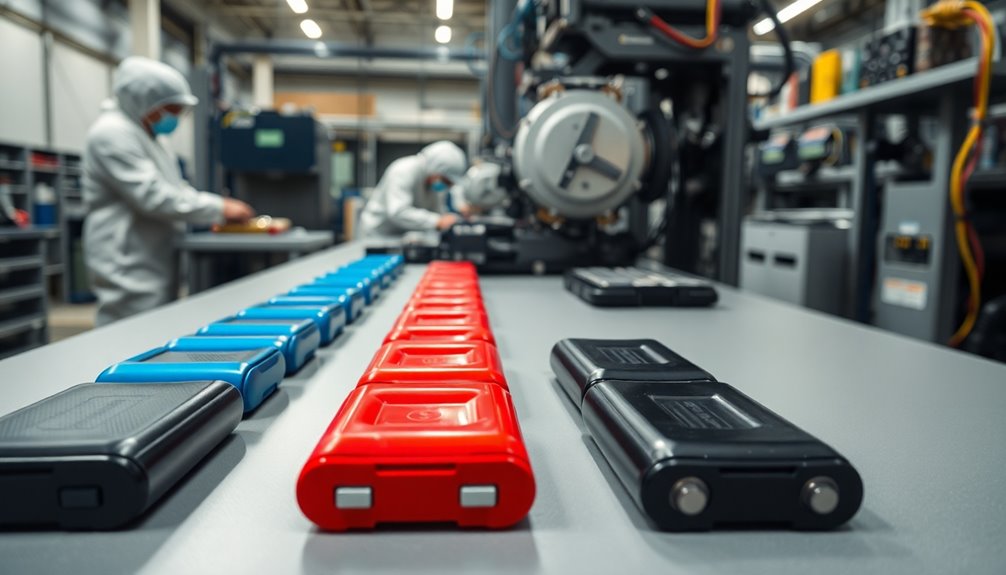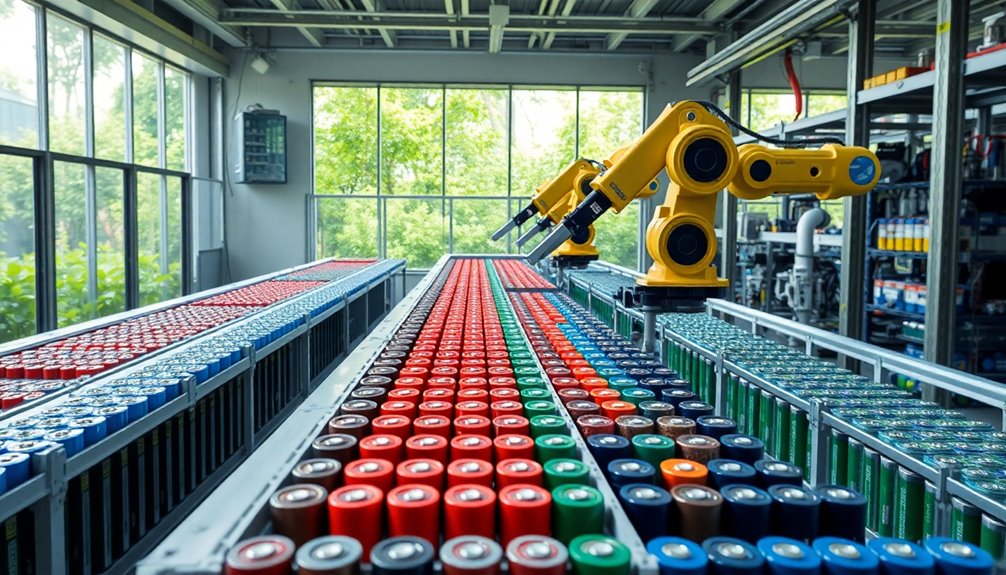Battery recycling is essential for protecting the environment and recovering valuable materials like metals from both rechargeable and non-rechargeable batteries. Different types, such as lithium-ion, lead-acid, and alkaline batteries, require specific recycling methods to guarantee safety and efficiency. Specialized processes like sorting, discharging, and mechanical or chemical recovery enable these materials to be reused. Understanding these steps helps you contribute to sustainability—keep exploring to discover how new innovations are shaping the future of battery recycling.
Key Takeaways
- Recycling prevents environmental harm by safely recovering valuable metals from both primary and rechargeable batteries.
- Batteries are sorted by chemistry and disassembled to remove external components before processing.
- Advanced techniques like hydrometallurgy and direct cathode recycling maximize metal recovery and reduce environmental impact.
- Proper disposal through vetted recycling programs helps conserve resources and supports a circular economy.
- Innovations aim to improve recovery rates up to 98%, promote sustainability, and simplify recycling with standardized protocols.
Understanding Different Types of Batteries and Their Recycling Needs

Understanding the different types of batteries and their recycling needs is essential for responsible disposal. You’ll encounter primary batteries like AA, AAA, 9-volt, D-cell, and button cells in everyday devices. These non-rechargeable batteries mainly contain alkaline or zinc-carbon chemistry, which makes recycling important to prevent environmental harm. Avoid tossing them in regular trash, as recycling centers can recover metals and reduce landfill waste. Rechargeable batteries, such as Nickel-Cadmium (NiCad) and Nickel-Metal Hydride (NiMH), are found in power tools, cameras, and electronics. They contain toxic metals like cadmium or less harmful materials, but still require proper recycling to recover valuable metals and prevent contamination. Lead-acid batteries, used in vehicles, and lithium-ion batteries, powering gadgets and electric cars, also need specialized recycling to safeguard the environment and conserve resources. Additionally, vetted recycling programs ensure these batteries are disposed of safely and sustainably. Proper recycling also helps recover valuable metals, reducing the need for mining new resources and minimizing environmental impact. As technology advances, innovative recycling methods are emerging to improve the efficiency and safety of battery recovery processes. Implementing battery recycling initiatives can significantly reduce hazardous waste and promote environmentally responsible practices.
The Processes Behind Battery Sorting and Preparation

The process of sorting and preparing batteries for recycling begins with collecting them from various sources like electronic stores, municipal programs, and mail-in services. Once collected, batteries are sorted based on their chemistry and physical features, which guides the processing approach. Sorting also helps identify damaged batteries or those with impurities that could hinder recycling. After sorting, external components such as casings, labels, and plastics are removed during disassembly. Batteries then undergo deactivation through full discharge and electrolyte freezing to ensure safety. Mechanical crushing breaks down cells into smaller pieces, exposing core materials for easier recovery. Specialized facilities handle these steps efficiently, using advanced equipment to prepare different battery types for subsequent recycling processes. Proper sorting and preparation are essential to maximize material recovery and ensure safety.
Exploring Recycling Techniques for Lithium-Ion Batteries

After batteries are sorted and prepared, recycling techniques for lithium-ion batteries become essential to recover valuable materials and reduce environmental impact. Hydrometallurgical methods use acids or solvents to leach metals like cobalt, nickel, manganese, and lithium, producing pure salts or metals suitable for reuse. Electro-hydrometallurgy applies electric currents to enhance recovery rates while minimizing energy use. Pyrometallurgical techniques involve smelting batteries at high temperatures, creating metal alloys and slag, but often lose lithium and generate more emissions. Direct cathode recycling focuses on restoring existing cathode materials, saving energy and preserving engineered structures, though it’s still developing. Emerging innovations like BRAWS combine water and CO2 to create greener, more sustainable processes, aiming to improve recovery and lower environmental impacts. Understanding the cost of processing is crucial for optimizing recycling efficiency and sustainability. Additionally, advancements in sound design technologies can help improve monitoring and automation during recycling processes, ensuring higher accuracy and safety. Incorporating regulatory frameworks can further promote environmentally responsible recycling practices and encourage industry adoption. Furthermore, developing cost-effective methods is vital to make lithium-ion battery recycling more accessible and scalable across different regions.
To support these efforts, research into renewable energy-powered recycling facilities can significantly reduce the carbon footprint of the entire process.
Recovering Materials and Benefits of Battery Recycling

Recovering materials from lithium-ion batteries enables you to reclaim valuable metals like cobalt, nickel, and lithium efficiently through various recycling methods. Companies such as RecycLiCo recover up to 99% of cathode metals from battery waste, while Li-Cycle achieves recovery rates of up to 95% with their patented processes. The recovered materials are often upcycled into high-purity, battery-ready components, reducing waste and decreasing reliance on virgin resources. These metals are reintroduced into the supply chain, boosting resource efficiency. The benefits extend beyond material recovery: recycling reduces environmental impact by preventing landfill disposal, conserving energy, and minimizing pollution. It also supports a circular economy that promotes sustainable practices and resource conservation. Implementing proper application timing during recycling processes can optimize metal extraction and improve overall efficiency. Proper process control is essential to ensure safe and effective recycling operations, minimizing hazards and maximizing output. Additionally, understanding the tanning space can be analogous to optimizing recycling processes—both require careful planning and adherence to safety standards to maximize benefits. Emphasizing advanced recycling technologies can further enhance recovery rates and reduce processing costs, making recycling more sustainable and economically viable. Recycling also offers economic advantages like cost savings and job creation—all essential for a cleaner, more sustainable future.
The Future of Battery Recycling: Innovations and Sustainability Goals

Innovations in battery recycling are driving remarkable improvements in efficiency and sustainability. New technologies like hydrometallurgical and direct recycling methods are boosting recovery rates to 95-98%, making the process more effective. These advancements support a circular economy, where materials are reused, reducing the need for mining. Companies are also exploring second-life applications, extending battery lifespans and cutting waste. Emerging battery tech, such as solid-state batteries and modular designs, will simplify recycling and enhance safety. Future infrastructure aims for regional recycling hubs and AI-optimized facilities, lowering costs and emissions. Additionally, developing recycling infrastructure is essential to meet the growing demand and ensure the widespread adoption of these innovative practices, especially as AI-optimized facilities become more prevalent in streamlining operations. Continued research and development in battery materials will further improve recovery efficiency and environmental benefits. Furthermore, implementing standardized recycling protocols can facilitate global cooperation and improve overall process consistency. Incorporating sustainable design principles during manufacturing can also significantly reduce environmental impact throughout a battery’s lifecycle. Sustainability goals focus on reducing lifecycle emissions by 80% and establishing global standards. Continuous innovation and sustainable practices will shape a greener, more efficient battery recycling landscape, helping you contribute to a cleaner future.
Frequently Asked Questions
How Can Consumers Properly Dispose of Different Battery Types?
You should check your local guidelines for proper disposal of different battery types. For alkaline and zinc-carbon batteries, you can usually toss them in the trash, but recycling is better when possible. Rechargeable batteries, like lithium-ion or NiMH, need to be taken to specialized recycling centers, retailers, or hazardous waste sites. Always handle batteries carefully, especially lithium ones, and never mix different types during disposal to prevent hazards.
What Safety Precautions Are Necessary During Battery Recycling?
Imagine handling a fragile treasure that could spark a wildfire if mishandled. During battery recycling, you must protect terminals with tape or plastic to prevent sparks. Keep batteries cool, dry, and separate new from used ones. Avoid overcrowding, and never toss them in household trash. By following these precautions, you’re like a guardian, preventing fires and safeguarding the environment while giving batteries a safe second life.
Are Recycled Battery Materials as Reliable as New Ones?
You might wonder if recycled battery materials are as reliable as new ones. The good news is, recycled cathode materials often outperform virgin ones in key aspects like longer lifespan and faster charging. They’re more consistent due to controlled manufacturing, and advances in recycling tech help maintain high purity and performance. While challenges remain, recycled materials can be just as dependable, supporting sustainable and cost-effective battery solutions.
How Does Battery Recycling Impact Global Supply Chains?
Battery recycling impacts global supply chains by making them more resilient and less dependent on imports. When you support recycling, you help recover critical materials like lithium, cobalt, and nickel, reducing the need for mining. This creates a more sustainable, domestic supply of raw materials, lowers costs, and strengthens industry stability. Additionally, recycling infrastructure fosters international cooperation, ensuring a steady flow of materials to meet growing demand worldwide.
What Are the Main Challenges Facing Battery Recycling Industry?
You face many challenges in the battery recycling industry. The variety in battery chemistry, components, and structures makes disassembly and processing complex. Infrastructure is limited, and costs often outweigh materials’ value, discouraging investments. Supply chain issues, such as material shortages and competition, add to the difficulties. Additionally, fluctuating market demands and technological differences require specialized recycling methods, making it hard to develop efficient, widespread recycling systems.
Conclusion
Just like a well-oiled machine, battery recycling keeps our world moving smoothly. By understanding different batteries, sorting them properly, and embracing new recycling techniques, you help recover valuable materials and reduce environmental harm. Every step you take is like a piece of a bigger puzzle, shaping a sustainable future. Your efforts in recycling batteries are essential—think of it as turning yesterday’s waste into tomorrow’s resources. Together, we can power a cleaner, greener planet.









